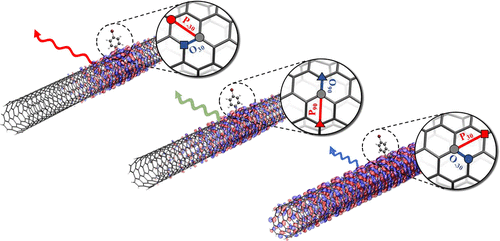当前位置:
X-MOL 学术
›
Acc. Chem. Res.
›
论文详情
Our official English website, www.x-mol.net, welcomes your
feedback! (Note: you will need to create a separate account there.)
Controlling Defect-State Photophysics in Covalently Functionalized Single-Walled Carbon Nanotubes.
Accounts of Chemical Research ( IF 16.4 ) Pub Date : 2020-08-17 , DOI: 10.1021/acs.accounts.0c00210 Brendan J Gifford , Svetlana Kilina 1 , Han Htoon , Stephen K Doorn , Sergei Tretiak
Accounts of Chemical Research ( IF 16.4 ) Pub Date : 2020-08-17 , DOI: 10.1021/acs.accounts.0c00210 Brendan J Gifford , Svetlana Kilina 1 , Han Htoon , Stephen K Doorn , Sergei Tretiak
Affiliation

|
Single-walled carbon nanotubes (SWCNTs) show promise as light sources for modern fiber optical communications due to their emission wavelengths tunable via chirality and diameter dependency. However, the emission quantum yields are relatively low owing to the existence of low-lying dark electronic states and fast excitonic diffusion leading to carrier quenching at defects. Covalent functionalization of SWCNTs addresses this problem by brightening their infrared emission. Namely, introduction of sp3-hybridized defects makes the lowest energy transitions optically active for some defect geometries and enables further control of their optical properties. Such functionalized SWCNTs are currently the only material exhibiting room-temperature single photon emission at telecom relevant infrared wavelengths. While this fluorescence is strong and has the right wavelength, functionalization introduces a variety of emission peaks resulting in spectrally broad inhomogeneous photoluminescence that prohibits the use of SWCNTs in practical applications. Consequently, there is a strong need to control the emission diversity in order to render these materials useful for applications. Recent experimental and computational work has attributed the emissive diversity to the presence of multiple localized defect geometries each resulting in distinct emission energy. This Account outlines methods by which the morphology of the defect in functionalized SWCNTs can be controlled to reduce emissive diversity and to tune the fluorescence wavelengths. The chirality-dependent trends of emission energies with respect to individual defect morphologies are explored. It is demonstrated that defect geometries originating from functionalization of SWCNT carbon atoms along bonds with strong π-orbital mismatch are favorable. Furthermore, the effect of controlling the defect itself through use of different chemical groups is also discussed. Such tunability is enabled due to the formation of specific defect geometries in close proximity to other existing defects. This takes advantage of the changes in π-orbital mismatch enforced by existing defects and the resulting changes in reactivities toward formation of specific defect morphologies. Furthermore, the trends in emissive energies are highly dependent on the value of mod(n-m,3) for an (n,m) tube chirality. These powerful concepts allow for a targeted formation of defects that emit at desired energies based on SWCNT single chirality enriched samples. Finally, the impact of functionalization with specific types of defects that enforce certain defect geometries due to steric constraints in bond lengths and angles to the SWCNT are discussed. We further relate to a similar effect that is present in systems where high density of surface defects is formed due to high reactant concentration. The outlined strategies suggested by simulations are instrumental in guiding experimental efforts toward the generation of functionalized SWCNTs with tunable emission energies.
中文翻译:

在共价功能化单壁碳纳米管中控制缺陷状态光物理。
单壁碳纳米管(SWCNT)的发射波长可通过手性和直径依赖性调节,因此有望成为现代光纤通信的光源。但是,由于存在低处的暗电子态和快速的激子扩散,导致缺陷处的载流子猝灭,因此发射量子产率相对较低。SWCNT的共价官能化通过加亮其红外发射来解决此问题。即,sp 3的介绍-杂化缺陷使某些缺陷几何形状的光学跃迁能量最低,并能进一步控制其光学性质。这种功能化的SWCNT目前是唯一在电信相关的红外波长下表现出室温单光子发射的材料。尽管这种荧光很强并且具有正确的波长,但是功能化会引入各种发射峰,从而导致光谱范围内的不均匀光致发光,从而阻碍了SWCNT在实际应用中的使用。因此,强烈需要控制发射的多样性,以使这些材料对应用有用。最近的实验和计算工作已将发射多样性归因于多个局部缺陷几何形状的存在,每个缺陷几何形状均导致不同的发射能量。该报告概述了可用来控制功能化SWCNT中缺陷形态的方法,以减少发射分集并调节荧光波长。探索了相对于单个缺陷形态的发射能量的手征性趋势。已经证明,源自SWCNT碳原子沿着具有强π轨道失配的键的官能化产生的缺陷几何形状是有利的。此外,还讨论了通过使用不同的化学基团来控制缺陷本身的效果。由于形成了与其他现有缺陷非常接近的特定缺陷几何形状,因此启用了这种可调性。这利用了由现有缺陷所引起的π-轨道失配的变化以及所形成的对特定缺陷形态的反应性的变化。此外,发射能量的趋势高度依赖于mod(n - m,3)表示(n,m)管的手性。这些功能强大的概念可根据SWCNT单手性富集样品,以所需的能量有针对性地形成缺陷,并以所需的能量发射。最后,讨论了由于键合长度和与SWCNT的角度受到空间限制而导致特定类型缺陷强制实施某些缺陷几何形状的功能化的影响。我们进一步涉及在由于高反应物浓度而形成高密度表面缺陷的系统中存在的类似效果。通过模拟提出的概述策略有助于指导实验工作,以产生具有可调发射能量的功能化SWCNT。
更新日期:2020-09-15
中文翻译:

在共价功能化单壁碳纳米管中控制缺陷状态光物理。
单壁碳纳米管(SWCNT)的发射波长可通过手性和直径依赖性调节,因此有望成为现代光纤通信的光源。但是,由于存在低处的暗电子态和快速的激子扩散,导致缺陷处的载流子猝灭,因此发射量子产率相对较低。SWCNT的共价官能化通过加亮其红外发射来解决此问题。即,sp 3的介绍-杂化缺陷使某些缺陷几何形状的光学跃迁能量最低,并能进一步控制其光学性质。这种功能化的SWCNT目前是唯一在电信相关的红外波长下表现出室温单光子发射的材料。尽管这种荧光很强并且具有正确的波长,但是功能化会引入各种发射峰,从而导致光谱范围内的不均匀光致发光,从而阻碍了SWCNT在实际应用中的使用。因此,强烈需要控制发射的多样性,以使这些材料对应用有用。最近的实验和计算工作已将发射多样性归因于多个局部缺陷几何形状的存在,每个缺陷几何形状均导致不同的发射能量。该报告概述了可用来控制功能化SWCNT中缺陷形态的方法,以减少发射分集并调节荧光波长。探索了相对于单个缺陷形态的发射能量的手征性趋势。已经证明,源自SWCNT碳原子沿着具有强π轨道失配的键的官能化产生的缺陷几何形状是有利的。此外,还讨论了通过使用不同的化学基团来控制缺陷本身的效果。由于形成了与其他现有缺陷非常接近的特定缺陷几何形状,因此启用了这种可调性。这利用了由现有缺陷所引起的π-轨道失配的变化以及所形成的对特定缺陷形态的反应性的变化。此外,发射能量的趋势高度依赖于mod(n - m,3)表示(n,m)管的手性。这些功能强大的概念可根据SWCNT单手性富集样品,以所需的能量有针对性地形成缺陷,并以所需的能量发射。最后,讨论了由于键合长度和与SWCNT的角度受到空间限制而导致特定类型缺陷强制实施某些缺陷几何形状的功能化的影响。我们进一步涉及在由于高反应物浓度而形成高密度表面缺陷的系统中存在的类似效果。通过模拟提出的概述策略有助于指导实验工作,以产生具有可调发射能量的功能化SWCNT。











































 京公网安备 11010802027423号
京公网安备 11010802027423号